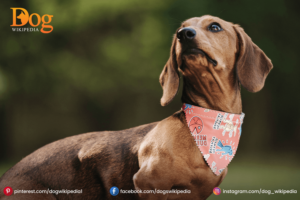Dachshunds : Introduction
Despite their charming appearance, dachshunds can suffer from a spinal cord illness called intervertebral disc disease (IVDD). This sickness can be avoided by following certain lifestyle recommendations, like upping physical activity and improving diet.
Dachshunds, the adored dog breed distinguished by their big bodies and short legs, were initially produced by German badger hunters. They weigh between sixteen to thirty-two pounds and have wirehaired, longhaired, or smooth coats. Coats are usually black and tan or reddish-brown in color.
1- Physical characteristics of Dachshunds
Dachshunds are distinguished by their distinct physical attributes. Their long, narrow body and small legs make them immediately identifiable. Adult Dachshunds often weigh 16 to 32 pounds and stand 6 to 10 inches tall. The shiny, short, silky coat requires little maintenance. The smooth, wavy coat of the longhaired pet needs frequent brushing to avoid matting. The wirehaired coat is dense and wiry, also requiring regular care.
The long, tapering nose, prominent jaw, dark almond-shaped eyes, and erect or drooping ears are characteristics of the head of a dachshund. Their legs are short and robust, with the hind legs straight and the front legs slightly bent. Their feet are oval-shaped and tiny.

2- Temperamental and Personality characteristics of Dachshunds
Dachshunds are renowned for having brave, fearless, and vivacious dispositions. They are amiable and devoted friends who are constantly willing to amuse and satisfy. Despite their diminutive stature, their courageous temperament makes them great watchdogs, warning owners of potential threats.
This fearlessness, though, can occasionally be mistaken for stubbornness, so teaching must be patient and constant. Dogs who are very gregarious and enjoy company are dachshunds. They can develop close relationships with family members and grow to be protective of those they care about.
3- Health Concerns of Dachshunds
-Food, environmental, and skin allergies
-A thyroid condition known as hypothyroidism
-Heart disorders (such as mitral valve disease and congestive heart failure)
– Asthma and pneumonia, or respiratory issues
-Digestive problems, including pancreatitis and unpleasant stomach
Keep a watch out for your Dachshund
• Soreness or rigidity
• Trouble walking
• Appetite loss
• Diarrhea or vomiting
• Modifications
4- Care and Nutrition of Dachshunds
Workout
-30 minute daily walks
-30 minutes of playtime
-Outdoor pursuits (such as swimming and hiking)
-Indoor games (fetch, hide-and-seek)
Nutrition
• Premium dog food
• Nutrient balance (protein, fat, and carbohydrates)
• Refrain from overeating (obesity)
• Feed two to three times a day
• Take into account diet programs
Preparing
-Apply a brush coat two to three times a week.
-Take a bath every two to three months.
-Every month, trim nails
– Weekly ear cleaning
-Every day, brush your teeth
Education
-Strategies for positive reinforcement
-Housebreaking (regular timetable)
-Fundamental obedience cues (come, sit, remain)
-Socialization with dogs, people, and surroundings
-Steer clear of penalties and unfavorable reinforcement.
Medicine
-Frequent visits to the vet
-Core and vaccinations

5- Interesting facts of Dachshunds
In Order to hunt badgers and other burrowing animals, Dachshunds which translates to “badger dogs” in German were first bred in the sixteenth century. They actually inherited their tremendous prey drive and natural swimming ability from their hunting forebears. Remarkably, because of their extended soft palate and thin trachea, Dachshunds are prone to snoring.
They’re also well-known for their “burrowing” Indoor games and activities are as important, particularly in bad weather. Encourage your Dachshund to explore and solve problems by hiding toys or goodies about the house. If done properly, stair climbing can support the preservation of leg strength.
Playtime bursts throughout the day help to avoid weight and boredom habit, which involves hiding in tight places or behind blankets. With three different coat types(smooth, longhaired, and wirehaired)and a range of colors.
6- Exercise of Dachshunds
Playtime should range anything from thirty minutes to an hour, including games like hide-and-seek and toy chasing. Hiking, swimming, and park exploration are excellent outdoor pursuits that provide both cerebral and physical pleasure. But keep in mind that too much exercise might cause joint problems and back pain in Dachshunds. Indoor games and activities are as important, particularly in bad weather.
Encourage your Dachshund to explore and solve problems by hiding toys or goodies about the house. If done properly, stair climbing can support the preservation of leg strength. Playtime bursts throughout the day help to avoid weight and boredom.
7- Numerous advantages of Dachshunds
Their kind and gregarious disposition offers warmth and company, easing feelings of tension and isolation. Because of their energetic temperament, dachshunds encourage regular walks and playtime, which contributes to a healthier lifestyle. They take up less space in apartments thanks to their compact size, which also allows them to provide a great lot of affection and friendship.
Owning a Dachshund has perks that go beyond its obvious physical attributes. They respond well to positive reinforcement training because they are intelligent and trainable, which helps to build a deep link between owner and pet. Due to their courageous and vigilant watchdog nature, dachshunds give their owners an extra layer of security by warning them of Potential dangers.

Conclusion
They are distinguished by their unique physical attributes, including as their tiny legs and long, thin bodies. They are perfect companions because of their sociable and devoted personality; they thrive on conversation and attention. Dachshunds are bright, trainable canines that respond well to consistent, patient positive reinforcement training.
Nonetheless, their susceptibility to health concerns like IVDD, obesity, and ocular disorders highlights the significance of routine veterinary examinations and well-balanced meals. Despite these difficulties, Dachshunds are adaptive and suited for apartment living since they offer affection, company, and motivation for physical activity.

